Jiayu G4 - the long-awaited Chinese flagship
It so happened that the second time in a row I become the owner of a smartphone from the company Jiayu. My previous Jiayu G2 (on the left), which I managed to use for about 9 months, has already managed to get used up, but the device really turned out to be a success, with its compact dimensions it had a productive processor, 1 GB of RAM and a 2000 mAh battery. But time does not stand still, new processors, new OS versions come out, and taking into account the fact that the Chinese do not particularly care about the further support of their devices, I decided to upgrade in terms of hardware. To all my regret, the smartphone with similar functionality / dimensions / price could not be found. Therefore, I had to raise the bar to a critical 4.7 inches. And the choice, as you already understood from the title, fell on the very “long-awaited Chinese flagship” - Jiayu G4 (on the right). About him and talk in this review.
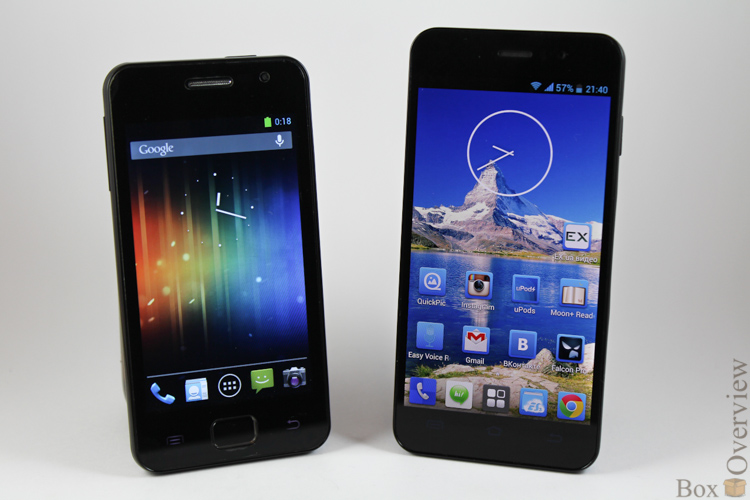
In fact, as of August 2013, calling Jiayu G4 a flagship is not entirely correct. This is due to the inherent slowness in the production of their smartphones by Jiayu. Initially, in January 2013, 2 versions of the smartphone were announced: standard (Standart) and flagship (Advanced). The differences were in the amount of RAM (1 and 2 GB), battery capacity (1850 vs. 3000 mAh) and, accordingly, the thickness of the device (8.2 vs. 10 mm).
As a result, after almost 4 months, the first batch of devices in the amount of 2000 pieces was released to the market, but, as is the case with Chinese manufacturers, everything mixed up and “The Queen gave birth to a son on the night of a son, a daughter, a mouse, not a frog , and an unknowable little animal. " The devices from the first batch received 1 GB of RAM and a 3000 mAh battery and were deprived of OTG support. Now the situation has improved and models with an overclocked MT6589T processor, two types of batteries (1850 and 3000 mAh) and in two colors (black and white) appeared in the free market, and the version with 2 GB of RAM and 32 GB of ROM as of August 2013 the year never came out. In this article, after a month of use, I will talk about the very “firstborn” whose characteristics are given below.
 4.7- inch IPS OGS screen with a resolution of 1280x720 and a protective coating of Gorilla Glass 2
4.7- inch IPS OGS screen with a resolution of 1280x720 and a protective coating of Gorilla Glass 2
 Quad - core processor Mediatek MT6589 (Cortex A7) with a working frequency of 1.2 GHz
Quad - core processor Mediatek MT6589 (Cortex A7) with a working frequency of 1.2 GHz
 Video Accelerator PowerVR SGX544MP
Video Accelerator PowerVR SGX544MP
 Android JB 4.2.2 operating system with a “custom” launcher and a pre-installed SuperUser
Android JB 4.2.2 operating system with a “custom” launcher and a pre-installed SuperUser
 1 GB of RAM
1 GB of RAM
 4 GB user memory + microSD card slot (up to 64 GB)
4 GB user memory + microSD card slot (up to 64 GB)
 2 cameras : rear 13 megapixel (CMOS BSI, LED, AF) and front 3 megapixel
2 cameras : rear 13 megapixel (CMOS BSI, LED, AF) and front 3 megapixel
 Communications: Wi-Fi (802.11 b / g / n), Bluetooth 4.0, GPS (with EPO and A-GPS), FM
Communications: Wi-Fi (802.11 b / g / n), Bluetooth 4.0, GPS (with EPO and A-GPS), FM
 In addition: USB OTG (it is missing in the phones from the first batch, which is mine)
In addition: USB OTG (it is missing in the phones from the first batch, which is mine)
 Li-pol 3000 mAh battery
Li-pol 3000 mAh battery
 Dimensions: 133x65x10 mm
Dimensions: 133x65x10 mm
 Weight: 180 grams
Weight: 180 grams
')
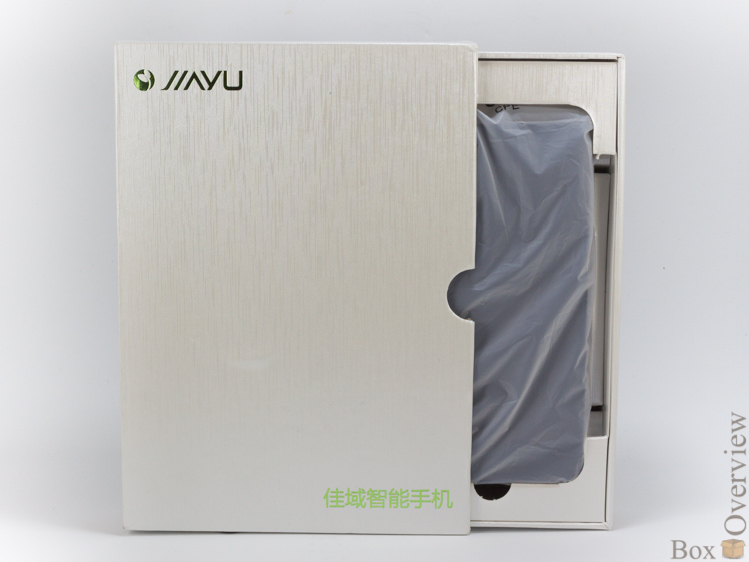
So dense that it can withstand the weight of two well-fed Chinese ( proof ). So you don’t have to worry about the safety of the device itself, the post, with all the desire, cannot ruin it, if it doesn’t lose it, of course

The package is modest: the device itself, the power supply unit (5V 1A), microUSB cable and warranty card. The instruction manual is located in the device's memory.

The power unit compared to that of the JY-G2 has also undergone changes. First, the output current has increased (up to 1A) in accordance with the increased battery capacity. Secondly, the design has changed, more precisely, at least some design has appeared.

But the absence of additional accessories in the basic package does not mean that they do not exist at all. In fact, the park of multi-colored covers, covers, and even Powerbank is large enough, but you will have to buy more separately. You can get acquainted in the official Jiayu store (be careful, Chinese).
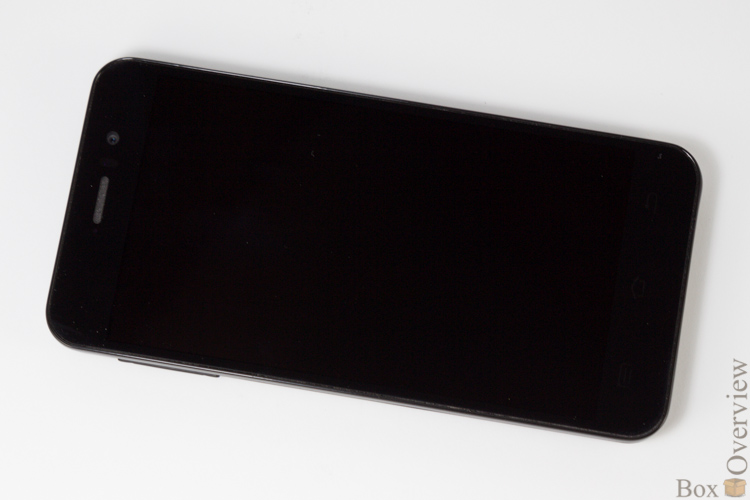
The high quality of protective glass is also indicated by the presence of a special oleophobic coating, so fingerprints do not appear as quickly as in the case of ordinary glass, but are easier to remove. In the lower part of the front panel are located the touch keys, devoid of illumination due to the design features. In the white version, these can be seen in the daytime, but the keys of the black Jiayu G4 are visible only at a certain angle. It would seem a trifle, and inexperienced users may experience problems when they first get acquainted with the device.

On the perimeter, the phone case is edged with a black metal frame, which is part of the smartphone frame. Located above the screen (from left to right): the warning LED (unlike the Jiayu G2 where the LED illuminated a good half of the ceiling like a light-scattering filter), a speaker (loud and clear, the interlocutor is heard perfectly), a couple of sensors (lighting and approximation) and front 3 megapixel camera.
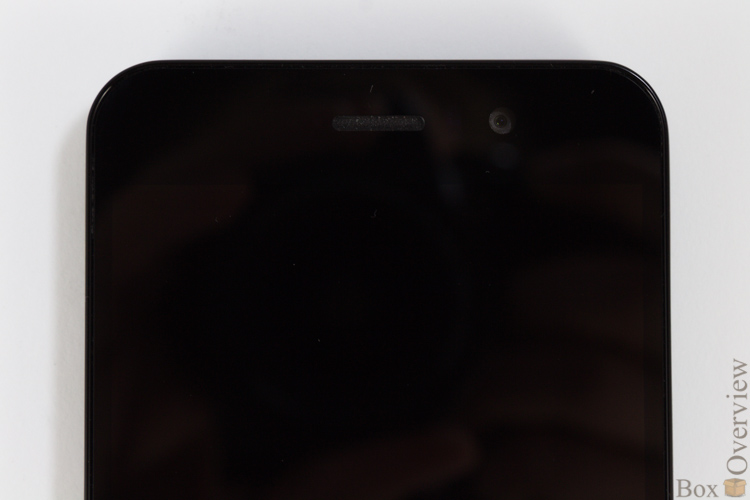
On the top of the lonely sheltered 3.5 mm headphone jack. At the bottom - a microphone, Micro-USB-compatible connector and a special slot for removing the back cover.

"Hardward" buttons are located on two opposite sides of the smartphone. On the right - power, on the left - the volume rocker. This arrangement will be convenient for both right-handers (blocking with your thumb, changing the volume with your index finger) and left-handers (vice versa). The buttons are quite tight, I would say even too much, but they have a good tactile response.

We turn to the other side. In its upper part there are: a camera, a flash LED, a company logo and a microphone of an active noise reduction system. The latter copes well with its tasks, the quality of transmitted speech in noisy places has improved.

Below is the external speaker (sound quality and volume at a good level) and one more, now a text logo of the company.

The back cover is made of flexible plastic with a soft-touch coating, which prevents the apparatus from slipping out of the hands. The cover is sturdy and tight to the phone. And yes, pay attention, thewhite version of the bullshit cover in the white version is made of ordinary glossy plastic.
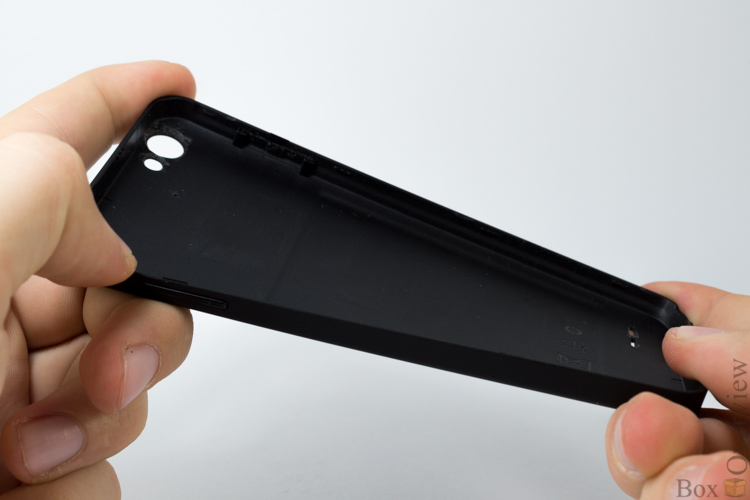
For myself, the design of the black Jiayu G4, or rather its absence as such, I think is perfect. Brutal bar with no inscriptions on the front panel covered with protective glass, the rear roof of rubberized plastic, metal frame. The assembly is also at a very high level. Squeaks and clearances between the parts are missing, nothing rings and does not hang out. What else is needed for complete happiness?
It should be noted that those 2.5 GB are reserved for the internal memory of the smartphone and for its full operation you will have to purchase a microSD memory card. For example, the camera will not work for you (save pictures) if a memory card is not inserted in the slot.
We proceed directly to the testing. The device is gaining a little more than 13 thousand points in the Antutu test and 4000 in the Quadrant:
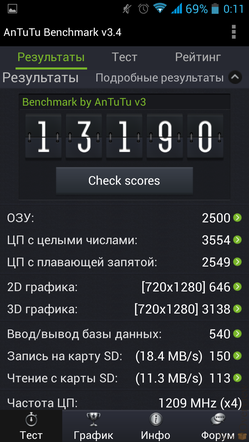

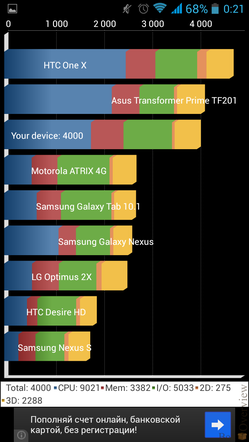
Multitouch in the smartphone supports up to 5 simultaneous touches. There are a whole bunch of sensors: accelerometer, light sensor and proximity sensor, gyroscope, orientation sensor and digital compass. Judging by the testimony of the test program, they all work correctly.

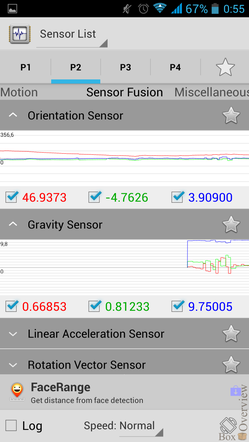

The operation of the GPS module also did not cause any complaints. A cold start takes up to 2 minutes, hot ~ 10 seconds. Unfortunately, the last week in my city was cloudy weather, respectively, and the testimony of the test program in such conditions.
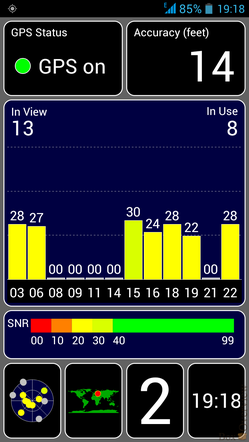
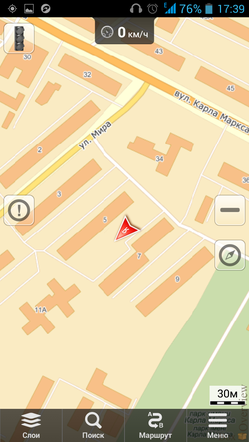
Autonomy. This parameter is one of the main trump cards of this device. In Antutu Tester, the smartphone scored a record 928 points.
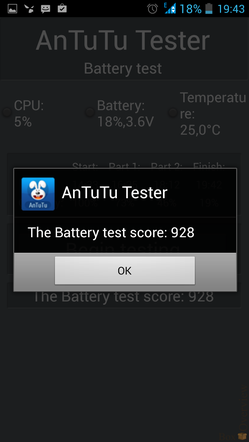
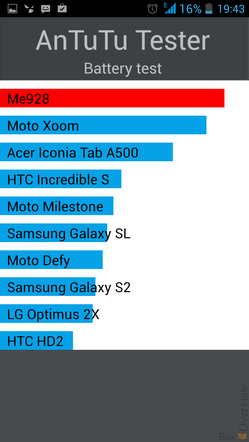
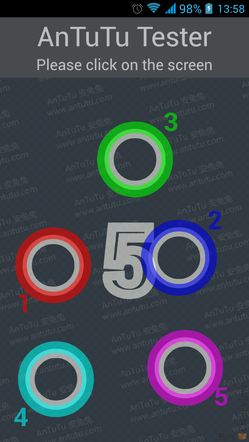
In everyday operation, the JY-G4 also shows excellent results, for example, in very intense mode, with constant use of GPS, Wi-FI alternately with 2G internet, listening to music, browsing or reading books, the device lived for 1 day and 14 hours. In a more benign mode, only about 25% of the charge is consumed per day, i.e. at least 4 days of battery life is provided to you.
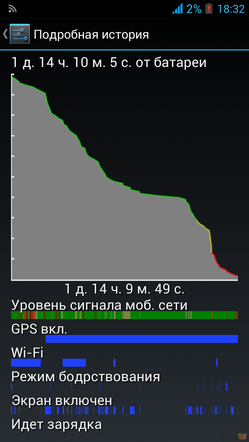

Such indicators have been achieved thanks to many factors: battery capacity, “correct” display resolution, because I have repeatedly said that such a diagonal is no longer needed, marketing 1080p is what they can do, so eat battery and load the processor, and the share of the latter in excellent indicators of autonomy is present.

For subsequent disassembly, you need to unscrew 8 screws around the perimeter of the back of the device.
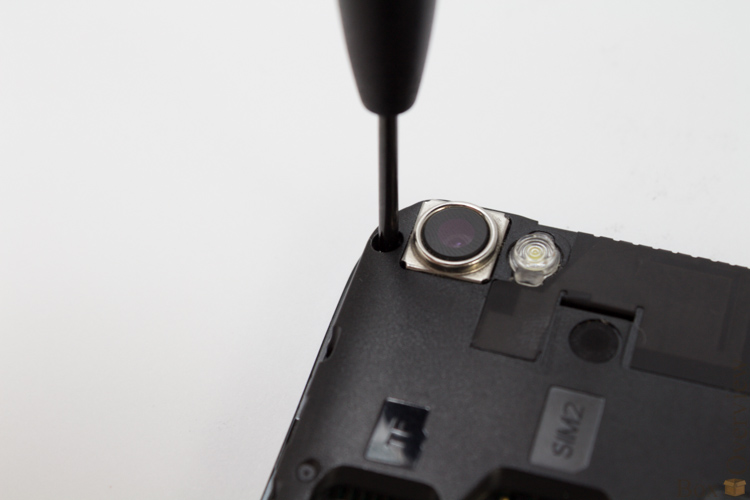
After that, armed with an unnecessary plastic card or a mediator, click off the plastic fasteners and remove the back panel.

With the previous step, you may experience “troubles”, since the back panel is additionally attached to the system board with tape (near the SIM card), but don’t despair, you just need to exert a little effort and it will come off.
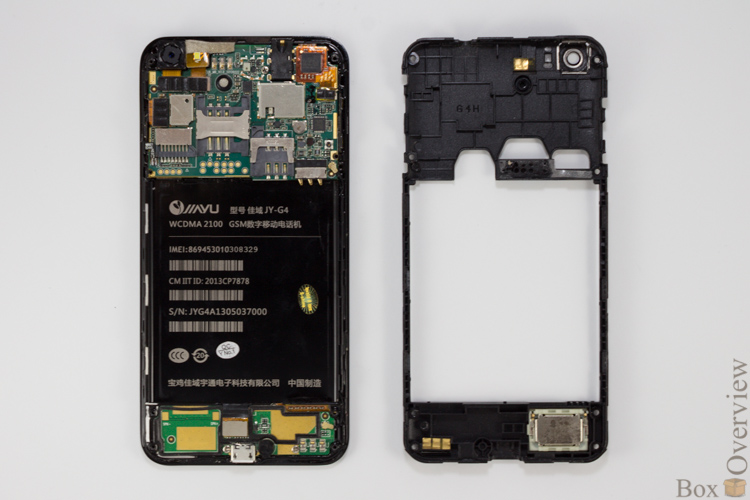
At the top of the device is the motherboard. Again - nothing new, the layout is standard, theflux is washed off . It makes no sense to shoot it, since everything is covered with screens from the back side, and I did not dare to unsolder them from my main phone.
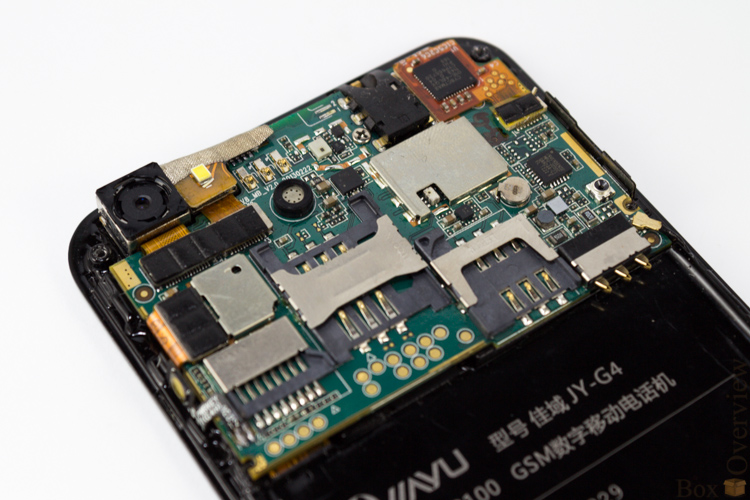
At the bottom - a printed circuit board with a microphone, microUSB connector, speaker and antenna connectors. Here you can contemplate the reason for the lack of illumination of the touch keys - a solid metal frame.
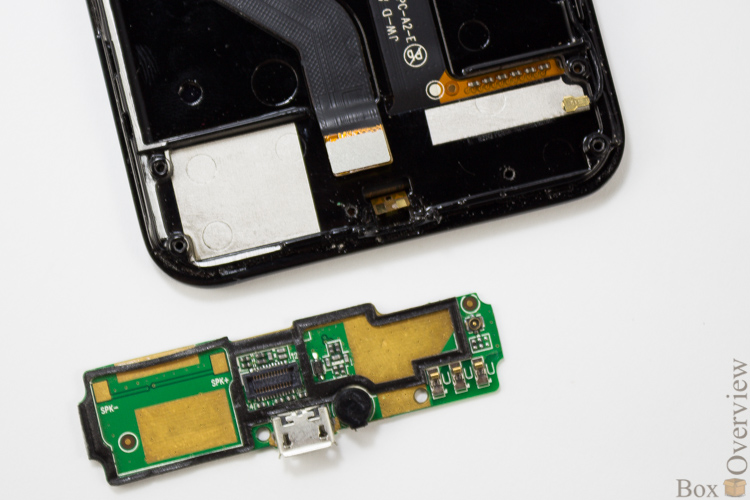
High build quality has become traditional for Chinese vehicles. Of course, the percentage of marriage here is higher than that of branded devices, but it can always be justified by the final price of the smartphone.
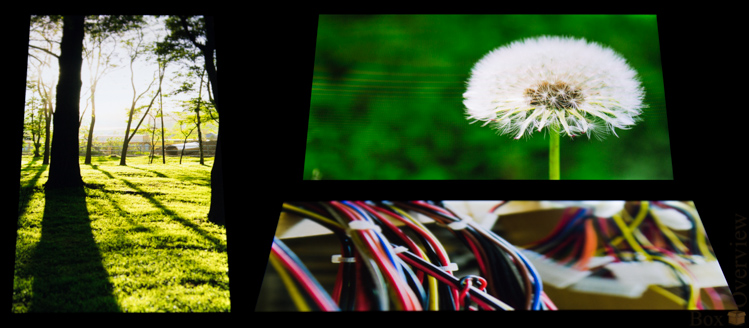
OGS (One Glass Solution) is a technology for producing displays, the essence of which is to combine the elements of the display and the outer glass together.
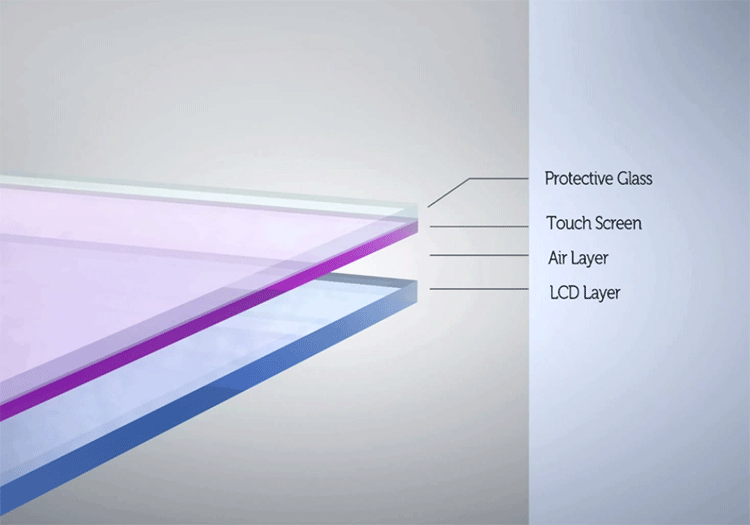
The use of such technology makes it possible to further increase the viewing angles, make the display thinner (which, in theory, should affect the thickness of the smartphone itself) and, most importantly, improve readability in bright sunlight.

The display resolution is 1280x720 pixels, which, in my humble opinion, is an ideal indicator for smartphones with screen sizes less than 5 inches. As part of the display, even nothing to complain about.


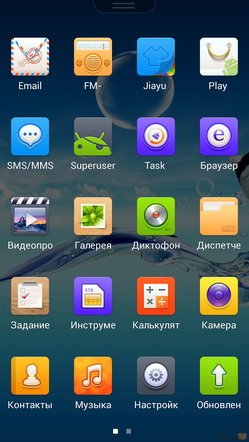
In general, the default interface is pleasant, but I, as a supporter of the “naked” Android, began to look for a solution to return to the original appearance of the system. The blessing did not have to go far, in the latest official firmware of July 12, the standard Android interface is used. I will not write another firmware manual, this is a trivial exercise and has been repeatedly described in many forums.
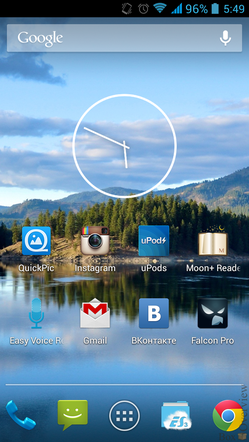
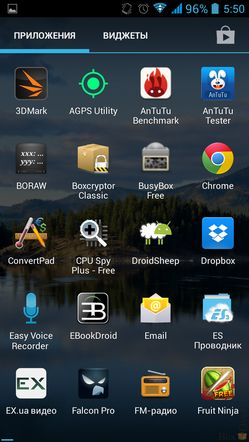
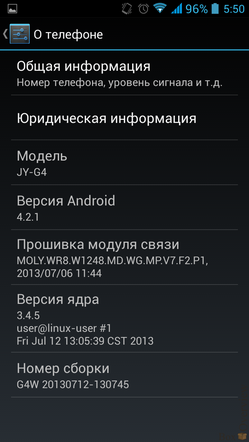
In general, the device is gradually, but confidently gaining new users, which means that the firmware will be sawed and finished. Already, in the profile topic (link above) on w3bsit3-dns.com there are several custom firmware and patches, but the main OS repository is located here (available LeWa OS, MIUI, etc.).


The minimum focusing distance is 5 cm. Macro of a smartphone is surprisingly good, so a test with a sheet of text will not be a problem either.

There is only one flash LED, so you should not flatter yourself on night photos. The maximum radius of action is no more than a meter.
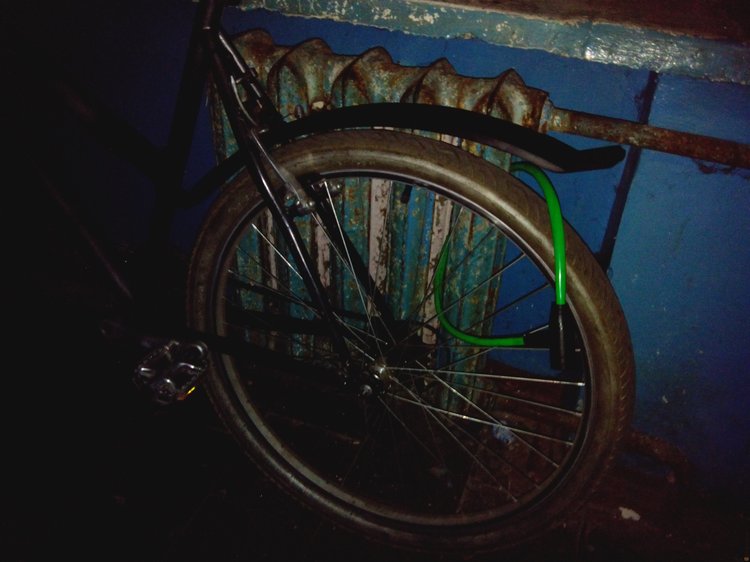
The front camera has also changed. Now this is a 3-megapixel module, but there are no complaints about it, there is enough quality for video calls,and if you mess a little with Snapseed, you can also post bows.
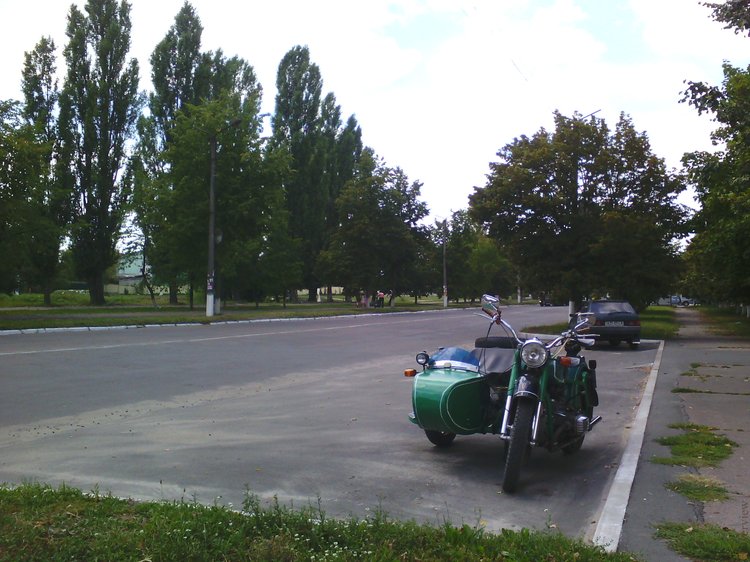
The device is also able to shoot video in FullHD quality. The quality of the video is average, there is a system of electronic stabilization and 4-fold digital zoom (by the way, in photo mode it also exists).
On the part of the camera, at the moment, it’s banal to brand flagship smartphones, there is nothing trivial, but with an average price range, you can "contend."
 Cost of
Cost of
 "Dvuhsimochnost"
"Dvuhsimochnost"
 Autonomy
Autonomy
 Ergonomics (thanks to the narrow frames around the display and the tight layout, the device is perfectly in the hand, even though the screen is quite large)
Ergonomics (thanks to the narrow frames around the display and the tight layout, the device is perfectly in the hand, even though the screen is quite large)
 Metal frame and practical housing materials
Metal frame and practical housing materials
 Productive hardware platform
Productive hardware platform
 Display, "showing" even in sunny weather and covered with a protective glass
Display, "showing" even in sunny weather and covered with a protective glass
 Active noise cancellation system, loud and clear speakers
Active noise cancellation system, loud and clear speakers
 LED (RGB) indicator + huge set of various sensors
LED (RGB) indicator + huge set of various sensors
 Supports OTG feature for phones released since mid-June
Supports OTG feature for phones released since mid-June
 The quality of the main camera is still far from ideal (no frontal pritenzy)
The quality of the main camera is still far from ideal (no frontal pritenzy)
 Subjectively - the volume and power buttons are tight
Subjectively - the volume and power buttons are tight
 Lack of backlight touch keys
Lack of backlight touch keys
 LED flash power
LED flash power
 Scanty grade
Scanty grade
The text can and certainly contains spelling, punctuation, grammar and other types of errors, including semantic ones. The author will be grateful for information about them (of course, in private), but does not guarantee their elimination.
Review from china-review.com.ua
Topic on w3bsit3-dns.com
Discussion on china-iphone.ru
If you do not have an account on Habrahabr, you can read and comment on our articles on BoxOverview.com

In fact, as of August 2013, calling Jiayu G4 a flagship is not entirely correct. This is due to the inherent slowness in the production of their smartphones by Jiayu. Initially, in January 2013, 2 versions of the smartphone were announced: standard (Standart) and flagship (Advanced). The differences were in the amount of RAM (1 and 2 GB), battery capacity (1850 vs. 3000 mAh) and, accordingly, the thickness of the device (8.2 vs. 10 mm).
As a result, after almost 4 months, the first batch of devices in the amount of 2000 pieces was released to the market, but, as is the case with Chinese manufacturers, everything mixed up and “The Queen gave birth to a son on the night of a son, a daughter, a mouse, not a frog , and an unknowable little animal. " The devices from the first batch received 1 GB of RAM and a 3000 mAh battery and were deprived of OTG support. Now the situation has improved and models with an overclocked MT6589T processor, two types of batteries (1850 and 3000 mAh) and in two colors (black and white) appeared in the free market, and the version with 2 GB of RAM and 32 GB of ROM as of August 2013 the year never came out. In this article, after a month of use, I will talk about the very “firstborn” whose characteristics are given below.
► Specifications
 4.7- inch IPS OGS screen with a resolution of 1280x720 and a protective coating of Gorilla Glass 2
4.7- inch IPS OGS screen with a resolution of 1280x720 and a protective coating of Gorilla Glass 2 Quad - core processor Mediatek MT6589 (Cortex A7) with a working frequency of 1.2 GHz
Quad - core processor Mediatek MT6589 (Cortex A7) with a working frequency of 1.2 GHz Video Accelerator PowerVR SGX544MP
Video Accelerator PowerVR SGX544MP Android JB 4.2.2 operating system with a “custom” launcher and a pre-installed SuperUser
Android JB 4.2.2 operating system with a “custom” launcher and a pre-installed SuperUser 1 GB of RAM
1 GB of RAM 4 GB user memory + microSD card slot (up to 64 GB)
4 GB user memory + microSD card slot (up to 64 GB) 2 cameras : rear 13 megapixel (CMOS BSI, LED, AF) and front 3 megapixel
2 cameras : rear 13 megapixel (CMOS BSI, LED, AF) and front 3 megapixel Communications: Wi-Fi (802.11 b / g / n), Bluetooth 4.0, GPS (with EPO and A-GPS), FM
Communications: Wi-Fi (802.11 b / g / n), Bluetooth 4.0, GPS (with EPO and A-GPS), FM In addition: USB OTG (it is missing in the phones from the first batch, which is mine)
In addition: USB OTG (it is missing in the phones from the first batch, which is mine) Li-pol 3000 mAh battery
Li-pol 3000 mAh battery Dimensions: 133x65x10 mm
Dimensions: 133x65x10 mm Weight: 180 grams
Weight: 180 grams')
► Packing and packaging
In many ways, Jiayu has evolved and the first thing that strikes you is the new packaging. Now, instead of a plastic tub, more resembling a food container than packing for a smartphone, there is a good box made of thick cardboard.
So dense that it can withstand the weight of two well-fed Chinese ( proof ). So you don’t have to worry about the safety of the device itself, the post, with all the desire, cannot ruin it, if it doesn’t lose it, of course

The package is modest: the device itself, the power supply unit (5V 1A), microUSB cable and warranty card. The instruction manual is located in the device's memory.

The power unit compared to that of the JY-G2 has also undergone changes. First, the output current has increased (up to 1A) in accordance with the increased battery capacity. Secondly, the design has changed, more precisely, at least some design has appeared.

But the absence of additional accessories in the basic package does not mean that they do not exist at all. In fact, the park of multi-colored covers, covers, and even Powerbank is large enough, but you will have to buy more separately. You can get acquainted in the official Jiayu store (be careful, Chinese).
► Appearance and ergonomics
According to the manufacturer, the entire front panel of the device is covered with Gorilla Glass 2. I did not manage to confirm this information, but the fact is that protective glass was actually installed in the Jiayu G4. I am not an admirer of films, which by the way was “defaulted” neatly pasted, while always carrying the phone through my pockets. So, after a month of use - not a single scratch, even a microscopic one.
The high quality of protective glass is also indicated by the presence of a special oleophobic coating, so fingerprints do not appear as quickly as in the case of ordinary glass, but are easier to remove. In the lower part of the front panel are located the touch keys, devoid of illumination due to the design features. In the white version, these can be seen in the daytime, but the keys of the black Jiayu G4 are visible only at a certain angle. It would seem a trifle, and inexperienced users may experience problems when they first get acquainted with the device.

On the perimeter, the phone case is edged with a black metal frame, which is part of the smartphone frame. Located above the screen (from left to right): the warning LED (unlike the Jiayu G2 where the LED illuminated a good half of the ceiling like a light-scattering filter), a speaker (loud and clear, the interlocutor is heard perfectly), a couple of sensors (lighting and approximation) and front 3 megapixel camera.

On the top of the lonely sheltered 3.5 mm headphone jack. At the bottom - a microphone, Micro-USB-compatible connector and a special slot for removing the back cover.

"Hardward" buttons are located on two opposite sides of the smartphone. On the right - power, on the left - the volume rocker. This arrangement will be convenient for both right-handers (blocking with your thumb, changing the volume with your index finger) and left-handers (vice versa). The buttons are quite tight, I would say even too much, but they have a good tactile response.

We turn to the other side. In its upper part there are: a camera, a flash LED, a company logo and a microphone of an active noise reduction system. The latter copes well with its tasks, the quality of transmitted speech in noisy places has improved.

Below is the external speaker (sound quality and volume at a good level) and one more, now a text logo of the company.

The back cover is made of flexible plastic with a soft-touch coating, which prevents the apparatus from slipping out of the hands. The cover is sturdy and tight to the phone. And yes, pay attention, the

For myself, the design of the black Jiayu G4, or rather its absence as such, I think is perfect. Brutal bar with no inscriptions on the front panel covered with protective glass, the rear roof of rubberized plastic, metal frame. The assembly is also at a very high level. Squeaks and clearances between the parts are missing, nothing rings and does not hang out. What else is needed for complete happiness?
► Hardware platform
The heart of this device is the MT6589 system-on-chip. This is the last available solution from Mediatek. It is based on the quad-core processor (Cortex-A7) and the PowerVR SGX544MP video accelerator. Available on 28-nanometer process technology. In addition to SoC, the device also carries on board 1 GB of RAM and 4 GB of flash drive (the user can use 2.5 GB). All this allows the smartphone to easily cope with viewing and recording video in FullHD-quality, games and other demanding applications. An exception may be the three-dimensional games of the last half year, not that they do not start at all, but the quality of the graphics will be at the minimum level.It should be noted that those 2.5 GB are reserved for the internal memory of the smartphone and for its full operation you will have to purchase a microSD memory card. For example, the camera will not work for you (save pictures) if a memory card is not inserted in the slot.
We proceed directly to the testing. The device is gaining a little more than 13 thousand points in the Antutu test and 4000 in the Quadrant:



Multitouch in the smartphone supports up to 5 simultaneous touches. There are a whole bunch of sensors: accelerometer, light sensor and proximity sensor, gyroscope, orientation sensor and digital compass. Judging by the testimony of the test program, they all work correctly.



The operation of the GPS module also did not cause any complaints. A cold start takes up to 2 minutes, hot ~ 10 seconds. Unfortunately, the last week in my city was cloudy weather, respectively, and the testimony of the test program in such conditions.


Autonomy. This parameter is one of the main trump cards of this device. In Antutu Tester, the smartphone scored a record 928 points.



In everyday operation, the JY-G4 also shows excellent results, for example, in very intense mode, with constant use of GPS, Wi-FI alternately with 2G internet, listening to music, browsing or reading books, the device lived for 1 day and 14 hours. In a more benign mode, only about 25% of the charge is consumed per day, i.e. at least 4 days of battery life is provided to you.


| Mode | Time minutes |
| 3D games (GTA Vice City, NFS Most Wanted) | 364 |
| 720p streaming video playback via MX Player (software decoding) | 454 |
► Interiors and maintainability
The design of the device with the exception of the introduction of the metal frame into the base of the case and the display of the OGS technology (more on this later) has not changed. We start the preparation with the removal of the back cover, for this purpose there is a special notch in the lower part of the device.
For subsequent disassembly, you need to unscrew 8 screws around the perimeter of the back of the device.

After that, armed with an unnecessary plastic card or a mediator, click off the plastic fasteners and remove the back panel.

With the previous step, you may experience “troubles”, since the back panel is additionally attached to the system board with tape (near the SIM card), but don’t despair, you just need to exert a little effort and it will come off.

At the top of the device is the motherboard. Again - nothing new, the layout is standard, the

At the bottom - a printed circuit board with a microphone, microUSB connector, speaker and antenna connectors. Here you can contemplate the reason for the lack of illumination of the touch keys - a solid metal frame.

High build quality has become traditional for Chinese vehicles. Of course, the percentage of marriage here is higher than that of branded devices, but it can always be justified by the final price of the smartphone.
► Display
The graph of the technical characteristics of the display includes at least 2 abbreviations - IPS and OGS. And if everything is clear with the first one (the widest viewing angles, a bright, sharp and even “juicy” picture), then I would like to dwell on the second one.
OGS (One Glass Solution) is a technology for producing displays, the essence of which is to combine the elements of the display and the outer glass together.

The use of such technology makes it possible to further increase the viewing angles, make the display thinner (which, in theory, should affect the thickness of the smartphone itself) and, most importantly, improve readability in bright sunlight.

The display resolution is 1280x720 pixels, which, in my humble opinion, is an ideal indicator for smartphones with screen sizes less than 5 inches. As part of the display, even nothing to complain about.
► Operating system and software
Jiayu G4 comes on the market with the pre-installed version of Andriod 4.2.2. A launcher from the manufacturer has been installed on top of the standard interface, something similar to that in the MIUI firmware. From the pleasant features: the ability to open / close the application menu with the swipe up and down, themes for every taste, smooth operation.


In general, the default interface is pleasant, but I, as a supporter of the “naked” Android, began to look for a solution to return to the original appearance of the system. The blessing did not have to go far, in the latest official firmware of July 12, the standard Android interface is used. I will not write another firmware manual, this is a trivial exercise and has been repeatedly described in many forums.



In general, the device is gradually, but confidently gaining new users, which means that the firmware will be sawed and finished. Already, in the profile topic (link above) on w3bsit3-dns.com there are several custom firmware and patches, but the main OS repository is located here (available LeWa OS, MIUI, etc.).
► Camera
In the role of the main camera in the hero of our today's review is a 13-megapixel module with a BSI-sensor and autofocus. The quality of photos compared to previous models has increased, but still far from ideal.

The minimum focusing distance is 5 cm. Macro of a smartphone is surprisingly good, so a test with a sheet of text will not be a problem either.

There is only one flash LED, so you should not flatter yourself on night photos. The maximum radius of action is no more than a meter.

The front camera has also changed. Now this is a 3-megapixel module, but there are no complaints about it, there is enough quality for video calls,

The device is also able to shoot video in FullHD quality. The quality of the video is average, there is a system of electronic stabilization and 4-fold digital zoom (by the way, in photo mode it also exists).
On the part of the camera, at the moment, it’s banal to brand flagship smartphones, there is nothing trivial, but with an average price range, you can "contend."
► Results
Chinese companies are growing and the Chinese mobile technology market as a whole is growing. A year later, there are shifts, and cardinal (recall the same package). As in terms of workmanship and in terms of the hardware platform, Chinese devices, if they were still not equal, then came very close to famous brands. And the software is already at the level, no, it is not perfect, but in terms of stability and overall speed of work a huge step forward has been made. All the drawbacks lie in the details, there is no touch key illumination, the built-in LED-flash is rather weak, the camera would still be sawed, but is it worth waiting for more from a smartphone with a price around $ 230-240? Write your opinion in the comments.Advantages and disadvantages
 Cost of
Cost of "Dvuhsimochnost"
"Dvuhsimochnost" Autonomy
Autonomy Ergonomics (thanks to the narrow frames around the display and the tight layout, the device is perfectly in the hand, even though the screen is quite large)
Ergonomics (thanks to the narrow frames around the display and the tight layout, the device is perfectly in the hand, even though the screen is quite large) Metal frame and practical housing materials
Metal frame and practical housing materials Productive hardware platform
Productive hardware platform Display, "showing" even in sunny weather and covered with a protective glass
Display, "showing" even in sunny weather and covered with a protective glass Active noise cancellation system, loud and clear speakers
Active noise cancellation system, loud and clear speakers LED (RGB) indicator + huge set of various sensors
LED (RGB) indicator + huge set of various sensors Supports OTG feature for phones released since mid-June
Supports OTG feature for phones released since mid-June The quality of the main camera is still far from ideal (no frontal pritenzy)
The quality of the main camera is still far from ideal (no frontal pritenzy) Subjectively - the volume and power buttons are tight
Subjectively - the volume and power buttons are tight Lack of backlight touch keys
Lack of backlight touch keys LED flash power
LED flash power Scanty grade
Scanty grade► Cost
You can buy a smartphone for $ 225 dollars by joining a group purchase on chinatablets.info . Also, I advise you to pay attention to at least productive, but cheaper ($ 169.99) Jiayu G3ST (the ST version differs from the usual G3 in a 3000 mAh battery and a new MT6589T processor). Well, if the budget is running out completely, then look towards the time-tested Jiayu G2 ($ 140, review here ).The text can and certainly contains spelling, punctuation, grammar and other types of errors, including semantic ones. The author will be grateful for information about them (of course, in private), but does not guarantee their elimination.
► Related Links
Product on the official website of the manufacturerReview from china-review.com.ua
Topic on w3bsit3-dns.com
Discussion on china-iphone.ru
If you do not have an account on Habrahabr, you can read and comment on our articles on BoxOverview.com
Source: https://habr.com/ru/post/190792/
All Articles